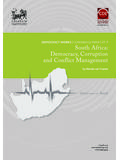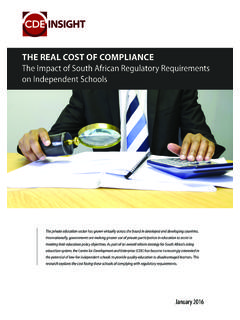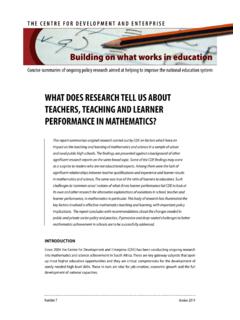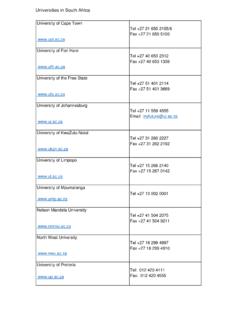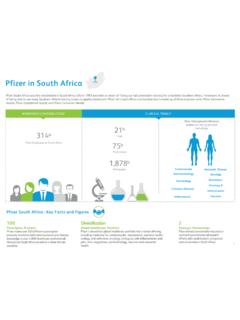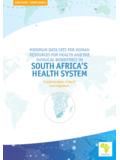Transcription of TEACHERS IN SOUTH AFRICA - CDE
1 TEACHERS IN SOUTH AFRICA . SUPPLY AND DEMAND 2013 2025. Executive Summary March 2015. The Centre for Development and Enterprise, SOUTH AFRICA 's leading development think tank, focuses on vital national development issues and their relationship to economic growth and democratic consolidation. Through examining SOUTH African realities and international experience, CDE formulates practical policy proposals for addressing major social and economic challenges. It has a special interest in the role of business and markets in development. Series editor: Ann Bernstein This is the executive summary of a report based on three background research papers written for CDE by Dr Charles Simkins, Dr Roger Deacon and Dr Peter Robinson.
2 The report was written by Dr Jane Hofmeyr (CDE's Education Policy and Advocacy Director) and Dr Kim Draper (CDE's Education Research Manager). The research was funded by the Sasol Inzalo Foundation. The funders do not necessarily agree with the views expressed in the report. The full report, as well as the CDE Technical Report: teacher supply and demand 2013-2025, are available on the website Published in March 2015 by The Centre for Development and Enterprise 5 Eton Road, Parktown, Johannesburg 2193, SOUTH AFRICA P O Box 1936, Johannesburg 2000, SOUTH AFRICA Tel +27 11 482 5140 Fax +27 11 482 5089 The Centre for Development and Enterprise All rights reserved.
3 This publication may not be reproduced, stored, or transmitted without the express permission of the publisher. It may be quoted, and short extracts used, provided the source is fully acknowledged. ISBN: 978-1-920653-18-7. TEACHERS IN SOUTH AFRICA : Supply and Demand 2013 2025. O ne of the greatest challenges facing the SOUTH African education system is the production of sufficient qualified, competent TEACHERS , who can provide quality teaching for all school subjects and phases. Whether SOUTH AFRICA is able to meet this critical challenge is a question that motivated the Centre for Development and Enterprise (CDE) to undertake research on teacher supply and demand.
4 Three experts were commissioned by CDE to undertake research for this report: Dr Roger Deacon and Dr Peter Robinson, respectively, investigated the public and private provision of initial teacher education, and Dr Charles Simkins modelled teacher supply and demand from 2013 to 2025, using 2012 and 2013 data on public and independent ordinary schools. This CDE report is based on their work and draws out some implications for education strategy and policy. It concludes with a summary of CDE's main findings and recommendations. The full report, as well as the CDE Technical Report: teacher supply and demand 2013-2025, are available on the website BACKGROUND.
5 Through initial teacher education (ITE) programmes offered at higher education institutions (HEIs) student TEACHERS obtain either a four-year Bachelor of Education (B Ed) degree or a one-year Post Graduate Certificate in Education (PGCE) after a three-year undergraduate degree. As both of these are four-year qualifications, the current official requirement for a qualified teacher in SOUTH AFRICA is known as M+4, a matric (school-leaving) certificate plus four years of ITE. Until fairly recently, however, M+3 (matric plus three years of ITE) was the official requirement, and so most TEACHERS in the country are qualified with M+3.
6 However, a qualified teacher is not necessarily a good teacher . Not all qualified TEACHERS are competent professionals able to provide quality teaching and learning. It is common cause that the quality of most ITE. programmes leaves a lot to be desired and the result is that most of the current teaching force has been inadequately educated and trained, whether during apartheid or in the recent past. MAIN FINDINGS. CDE's research and modelling covered extensive ground so only the main findings are summarised below. Government Strategy Significant development: Government's 2011 Integrated Strategic Planning Framework for teacher Education and Development (ISPFTED) was launched with its primary outcome to improve the quality of teacher education and development in order to improve the quality of TEACHERS and teaching.
7 1 This provided a clear strategy and plan that was accepted by all stakeholders and covered the full scope of CDE EXECUTIVE SUMMARY 1. TEACHERS IN SOUTH AFRICA : Supply and Demand 2013 2025. teacher development. Both quantitative and qualitative challenges were identified. However, there are certain weaknesses in the Plan: the lack of measurable deliverables and specific annual targets, a model of expansion based on the existing models of ITE at public higher education institutions (HEIs) which excluded new and innovative approaches, neglect of professional development for teacher educators, and a lack of attention to the role the private sector could play in the future.
8 Progress in achieving the goals of ISPFTED: The two national education departments have made impressive progress in achieving the short- and medium-term quantitative goals of the ISPFTED through expanding ITE provision at public HEIs and achieving significant increases in enrolments and graduates, as outlined below. Government has also begun to address the quality challenges by implementing the policy on The Minimum Requirements for teacher Education Qualifications (MRTEQ) in 2011. This requires all ITE. programmes to be re-designed with particular emphasis on subject content knowledge, how to teach that content knowledge, and the practice teaching component.
9 To date 73 per cent of ITE programmes have been approved by DHET. It has also allocated additional funding to public HEIs to strengthen their ITE programmes and co-funded new research investigating the quality and relevance of ITE programmes at five public HEIs. teacher Supply and Demand until 2025. Five datasets were used to construct the CDE This proved to be a complex and laborious task because the various data sources are inaccurate, incomplete, and inconsistent in what they include. Education researchers encounter numerous data problems. Typically education databases are unreliable because the data is not entered correctly or is incomplete, or it is out of date.
10 None of the datasets used for the CDE research agree on key issues like the number of TEACHERS or Grade R enrolments. In addition, in some years government reports include certain important data and then in other years this is omitted. For example, in 2012 KwaZulu-Natal (KZN) returned no Annual School Survey (ASS) data on educators to the Department of Basic Education (DBE). As KZN is the province which has the most learners and employs the greatest number of TEACHERS , this presented a significant challenge for the modelling. Consequently, CDE has had to spend considerable resources to try to unravel the inconsistencies and reconstruct missing information.



